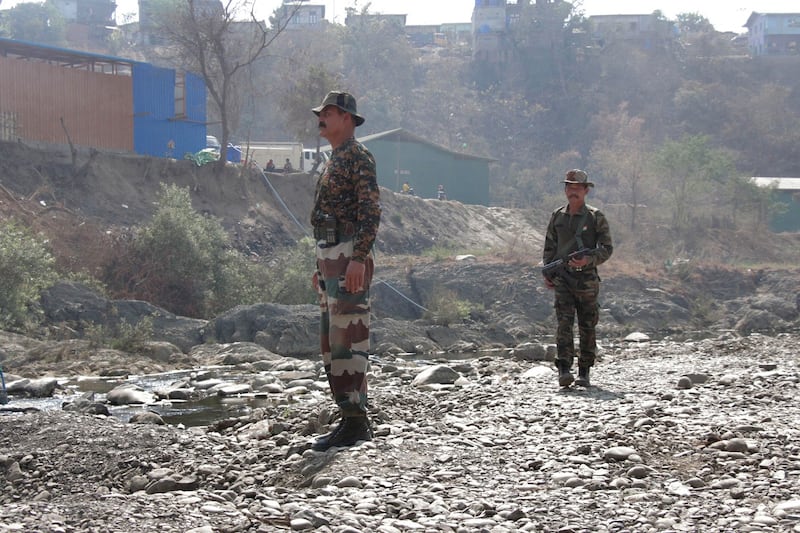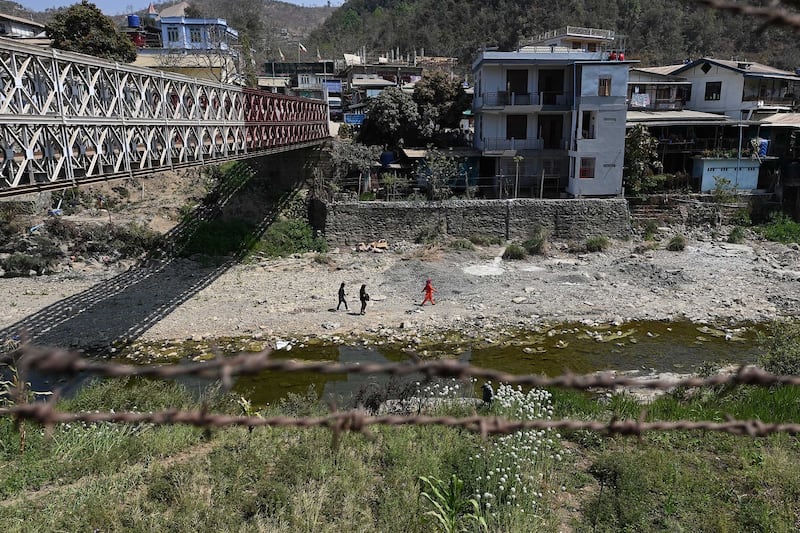India has locked the gates to key border crossings with Myanmar’s Chin state after three Indian citizens were killed in the state last month, according to sources from the area.
The closure comes amid an intensified military offensive against rebel forces in Chin state, where on April 10, a junta jet dropped bombs near a high school in Falam township, killing nine civilians and injuring four others.
Thousands of Myanmar nationals have fled fighting and taken refuge across the border in India’s Mizoram state.
Sources told RFA Burmese that on March 22, the charred remains of three Myanmar-born ethnic Chin women holding Indian citizenship were discovered in Matupi. An investigation identified the victims as C. Biaksuii, 48, Bablu Talukdar, 37, and B. Lathafamkima, 44, but has yet to determine who is responsible for their deaths.
In the aftermath of the discovery, civil society organizations in Mizoram issued a statement warning Indian nationals against traveling into Myanmar and on April 6, Indian authorities shuttered the two main border gates at Matupi’s Hlungmang and Gawnglaung villages, residents told RFA. Additionally, crossings accessed from the Chin towns of Rihkhawdar and Thantalan were also closed by the Indian side, they said.
A resident of Matupi, who declined to be named for security reasons, told RFA that the closure of the border gates had cut off access to food, medical treatment, and refuge for inhabitants of the township.
“The closure of the border is mostly related to the murder of Indian nationals,” the resident said. “It’s caused a lot of trouble for Myanmar refugees in Matupi. They can’t enter the Indian side for now.”
Attempts by RFA to contact Thant Zin, the junta’s social affairs minister and spokesman for Chin state, for comment on the measures taken to restrict border crossings went unanswered Tuesday.

Salai Dokhar, the founder of India-based aid group India For Myanmar, urged Myanmar nationals in India to refrain from illegal activities, saying that doing so could impact refugees who have already fled across the border.
“What I mean by ‘illegal’ includes doing business illegally, committing crimes and that sort of activity,” Dokhar told RFA. “I urge all Myanmar refugees not to become involved in such activities because one person’s crime can impact tens of thousands of refugees sheltering in India.”
Arrests in Manipur
Following the deaths of the three Indian nationals, residents of India’s Manipur state, which also borders Chin state to the north, said that they have seen authorities conduct a series of arrests of Myanmar nationals on the grounds of illegal immigration.
In one incident on April 6, authorities in Manipur arrested a group of six men, 11 women, and six children from Myanmar who had fled across the border to Langkaur township and were working in the local weaving industry, Myanmar refugees told RFA.
“The reason for their arrest is that they did not have permission to stay in the town,” a Myanmar national in Langkaur told RFA. “They were supposed to stay in temporary refugee shelters being built by the Manipur government. They are being kept in a temporary detention center for now and will be moved to the refugee shelters once they are complete.”
Police in Manipur began hunting Myanmar nationals living in the state at the start of the year and, as of the beginning of March, had arrested around 170 people, according to aid workers assisting refugees.

On March 26, Manipur government officials visited villages in Moreh township where Myanmar refugees are sheltering to announce the construction of the camps, which they said will be able to accommodate half of the more than 10,000 who have fled across the border into the state.
“They came and took pictures of the refugees and issued refugee identity cards to them … saying that it will be more secure to live there,” said a refugee in Moreh, who spoke to RFA on condition of anonymity. “They have made a list of the refugees, too. We are currently staying near the villages along the border.”
RFA emailed the Indian Embassy in Yangon inquiring after the border closure and the arrests of refugees in Manipur, but had yet to receive a response as of Tuesday evening.
According to Chin civil society organizations, around 60,000 people have been displaced by fighting in Chin state, while some 50,000 others have fled across the border to Mizoram and Manipur states in India.
Translated by Myo Min Aung. Edited by Joshua Lipes and Malcolm Foster.
